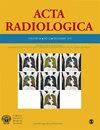Acetabular morphology variations in a Hispanic population.
IF 1.1
4区 医学
Q3 RADIOLOGY, NUCLEAR MEDICINE & MEDICAL IMAGING
引用次数: 0
Abstract
BACKGROUND Rotational abnormalities of the hip have been implicated in the etiology of diseases, such as hip dysplasia, osteoarthritis, and femoroacetabular impingement. Despite the extensive literature on hip morphology, there is a gap in knowledge regarding variations in the Hispanic population. PURPOSE To describe the bony anatomy variations of the acetabulum in a Hispanic population. MATERIAL AND METHODS This is a cross-sectional study. We studied 182 computed tomography (CT) images in patients aged older than 21 years, who had undergone pelvic CT for any condition, except hip fracture. Measurements of acetabular version, anterior and posterior acetabular sector angles (AASA/PASA) and horizontal acetabular sector angles (HASA) were made. Acetabular variations were then compared to weight and sex data. RESULTS The mean acetabular anteversion was greater in women (P < 0.001). Women exhibited a greater PASA (P < 0.05); however, men had a greater AASA (P < 0.05). Underweight individuals had a smaller PASA (P < 0.01) and HASA (P < 0.05) than individuals with a normal weight. CONCLUSION The Hispanic hip is morphologically similar to other populations previously reported in the literature; however, Hispanic men have less coverage of the femoral head by the posterior acetabular wall when compared to women of the same ethnicity. These abnormalities have a direct impact on management and surgical approach in patients treated for femoroacetabular impingement and hip dysplasia.西班牙裔人群的髋臼形态变化。
背景髋关节旋转异常与髋关节发育不良、骨关节炎和股骨髋臼撞击等疾病的病因有关。尽管有关髋关节形态学的文献很多,但有关西班牙裔人群髋关节形态变化的知识还是空白。我们研究了 182 张计算机断层扫描(CT)图像,研究对象是 21 岁以上、因任何疾病(髋部骨折除外)接受骨盆 CT 检查的患者。我们测量了髋臼形态、髋臼前后扇形角(AASA/PASA)和髋臼水平扇形角(HASA)。结果女性的平均髋臼前倾角更大(P < 0.001)。女性的 PASA 更大(P < 0.05);但男性的 AASA 更大(P < 0.05)。与体重正常的人相比,体重不足的人的 PASA(P < 0.01)和 HASA(P < 0.05)更小。结论:西班牙裔髋关节在形态上与之前文献报道的其他人群相似;但是,与同种族的女性相比,西班牙裔男性的股骨头较少被髋臼后壁覆盖。这些异常直接影响到股骨髋臼撞击症和髋关节发育不良患者的治疗和手术方法。
本文章由计算机程序翻译,如有差异,请以英文原文为准。
求助全文
约1分钟内获得全文
求助全文
来源期刊

Acta radiologica
医学-核医学
CiteScore
2.70
自引率
0.00%
发文量
170
审稿时长
3-8 weeks
期刊介绍:
Acta Radiologica publishes articles on all aspects of radiology, from clinical radiology to experimental work. It is known for articles based on experimental work and contrast media research, giving priority to scientific original papers. The distinguished international editorial board also invite review articles, short communications and technical and instrumental notes.
 求助内容:
求助内容: 应助结果提醒方式:
应助结果提醒方式:


